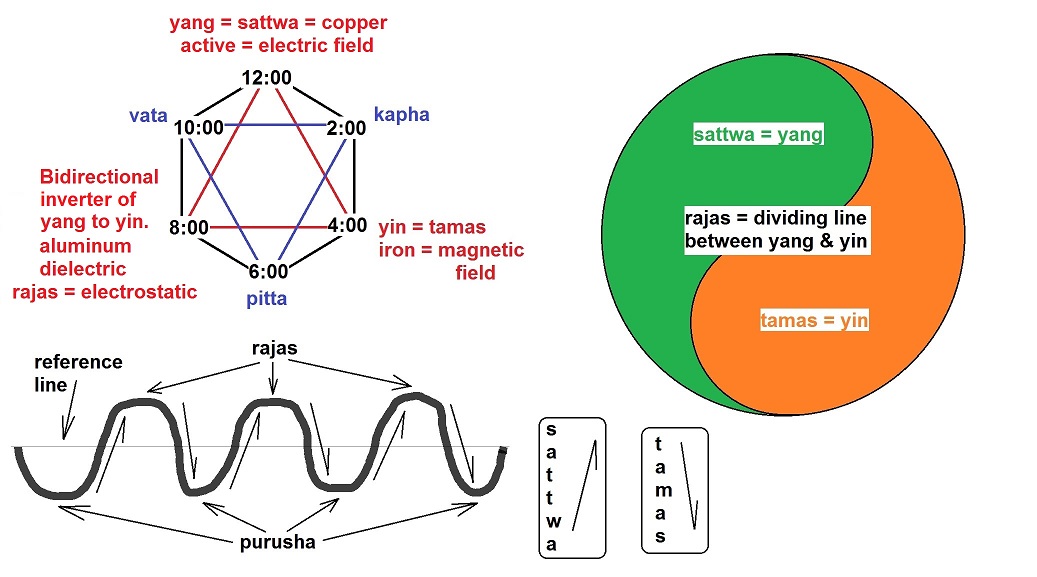Aluminum is a Reflector from another standpoint...
To recapitulate...
Aluminum, represented by rajas guna, is a bidirectional reflector of yang to yin and yin to yang just as a one-way mirror could be a reflector from both sides: from the side of yang looking at yin and from the side of yin looking at yang. By way of inversion, yin takes on the appearance of yang - hence, yang sees only itself when looking at yin. Neither does yang see the divider between itself and yin. Likewise, by way of inversion, yang takes on the appearance of yin - hence, yin sees only itself when looking at yang. Neither does yin see the divider between itself and yang.
Rajas represents dielectricity; yang and yin represent electromagnetism.
But reflectivity is also between the aetheric source of energy and dielectricity. So, reflectivity is a two-stage process.
First, aluminum (in Tesla's Tri-Metal Generator, for instance) reflects energy from the aether into dielectricity. Second, aluminum reflects the balance between electric and magnetic fields. So, reflectivity is a conversion as well as a balancing act of inversion. If reflection did not invert (and divert) opposites back towards each other, balance could not be maintained.
So, here is described two axis of conceptual orientation: one vertical, and one horizontal.
Without vertical reflectivity, no assistance could be had from the aetheric source of energy making dead matter lively.
And without horizontal reflectivity, no apparent interplay could be achieved by separating the oppositional gunas of sattwic yang and tamasic yin from each other to maintain their individuality. Rajasic dielectricity is already a combination of opposites preventing any further loss of unique identity among the opposites of sattwic electricity and tamasic magnetism. The dielectricity of rajas makes a further sacrifice by disappearing between the opposite gunas of sattwa and tamas to promote their prominence as the electric field of sattwa and the magnetic field of tamas.
So, if dielectricity likes to disappear and let electromagnetism get all of the credit for powering our modern world, how much more so does the aether do likewise.
Reflectivity is a self-sacrificing act of selfless service invoking both the conversion of aetheric energy into dielectricity via its transformation (not unlike a step-down, or step-up, transformer) and the inversion of the electrical opposite to magnetism via the dielectrical boundary between them. In a sense, this would imply that the counter-space of dielectricity is a boundary to unique spacial domains, each domain of which contains its own predominating value of either a sattwic realm of an electric field, or else a predominating realm of tamasic magnetism.
Originally posted by Vinyasi
View Post
Aluminum, represented by rajas guna, is a bidirectional reflector of yang to yin and yin to yang just as a one-way mirror could be a reflector from both sides: from the side of yang looking at yin and from the side of yin looking at yang. By way of inversion, yin takes on the appearance of yang - hence, yang sees only itself when looking at yin. Neither does yang see the divider between itself and yin. Likewise, by way of inversion, yang takes on the appearance of yin - hence, yin sees only itself when looking at yang. Neither does yin see the divider between itself and yang.
Rajas represents dielectricity; yang and yin represent electromagnetism.
But reflectivity is also between the aetheric source of energy and dielectricity. So, reflectivity is a two-stage process.
First, aluminum (in Tesla's Tri-Metal Generator, for instance) reflects energy from the aether into dielectricity. Second, aluminum reflects the balance between electric and magnetic fields. So, reflectivity is a conversion as well as a balancing act of inversion. If reflection did not invert (and divert) opposites back towards each other, balance could not be maintained.
So, here is described two axis of conceptual orientation: one vertical, and one horizontal.
Without vertical reflectivity, no assistance could be had from the aetheric source of energy making dead matter lively.
And without horizontal reflectivity, no apparent interplay could be achieved by separating the oppositional gunas of sattwic yang and tamasic yin from each other to maintain their individuality. Rajasic dielectricity is already a combination of opposites preventing any further loss of unique identity among the opposites of sattwic electricity and tamasic magnetism. The dielectricity of rajas makes a further sacrifice by disappearing between the opposite gunas of sattwa and tamas to promote their prominence as the electric field of sattwa and the magnetic field of tamas.
So, if dielectricity likes to disappear and let electromagnetism get all of the credit for powering our modern world, how much more so does the aether do likewise.
Reflectivity is a self-sacrificing act of selfless service invoking both the conversion of aetheric energy into dielectricity via its transformation (not unlike a step-down, or step-up, transformer) and the inversion of the electrical opposite to magnetism via the dielectrical boundary between them. In a sense, this would imply that the counter-space of dielectricity is a boundary to unique spacial domains, each domain of which contains its own predominating value of either a sattwic realm of an electric field, or else a predominating realm of tamasic magnetism.


Comment